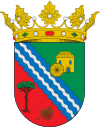Molinos de Duero
| Molinos de Duero municipality | ||
|---|---|---|
 Molinos de Duero - Town Hall
|
||
| coat of arms | Map of Spain | |

|
|
|
| Basic data | ||
| Autonomous Community : |
|
|
| Province : | Soria | |
| Comarca : | Pinares | |
| Coordinates | 41 ° 53 ′ N , 2 ° 47 ′ W | |
| Height : | 1100 msnm | |
| Area : | 27.39 km² | |
| Residents : | 162 (Jan. 1, 2019) | |
| Population density : | 5.91 inhabitants / km² | |
| Postal code : | 42156 | |
| Municipality number ( INE ): | 42117 | |
| administration | ||
| Website : | www.molinosdeduero.es | |
Molinos de Duero is a place and a small mountain community with only 162 inhabitants (as of January 1, 2019) in the southeast of the Spanish province of Soria in the autonomous community of Castile-Leon .
location
The place Molinos de Duero is located on the upper reaches of the Río Duero in the mountain landscape in the heart of the province of Soria at an altitude of approx. 1100 meters above sea level. d. M. The distance to the southeastern provincial capital Soria is about 38 kilometers (driving distance). The Embalse de la Cuerda del Pozo reservoir and the neighboring towns of Vinuesa and Salduero are both just a few kilometers away.
Population development
| year | 1960 | 1970 | 1981 | 1991 | 2001 | 2012 |
| Residents | 334 | 247 | 187 | 189 | 187 | 182 |
In the first half of the 20th century, the number of inhabitants was usually well over 300. The increasing mechanization of agriculture and the resulting loss of jobs have contributed to the significant decline in the population in recent decades.
economy
For centuries the place served as an important trade, craft and service center for the rural villages and farmsteads in the area. It was also an important station in the system of trade and livestock routes ( Cabaña Real de Carreteros ) in northern Spain. Today tourism in the form of renting out holiday homes ( casas rurales ) plays a not insignificant role for the town's income.
history
After the Arab-Moorish conquest , large areas in the north of the Iberian Peninsula were depopulated . Not until the beginning of the 10th century under the Castilian Count Gonzalo Téllez and then in the second half of the 11th century under Alfonso VI. the area was recaptured ( reconquista ) and repopulated ( repoblación ) by the Christians .
Attractions
- The church of Molinos de Duero ( Iglesia de San Martin de Tours ), built partly from field stones and partly from roughly worked stone , is a single-nave late Gothic building with a transept and an entrance on the south side protected by a portico that was added later . The bells are not located inside the bell storey, but are hung in the sound openings themselves; the bell gable facing the square and the corner decorations are baroque ingredients. There are several baroque altarpieces inside the church ; the choir itself has been redesigned in the neoclassical style .
- A court pillar ( roller blind ) with a crowned wrought-iron cross rises on a plinth that has been stepped down several times in front of the church .
- Today's town hall ( ayuntamiento ) is located in a former storage building built in 1789. In a wall niche is the equestrian statue of the patron saint of St. Martin .
- The Real Posada de la Mesta is the architectural gem of the place and was copied for the world exhibition in Barcelona (1929) as an outstanding example of the architecture of the province of Soria.
- Several houses in the village still show stone coats of arms ( blasones ).
Web links
Individual evidence
- ↑ Cifras oficiales de población resultantes de la revisión del Padrón municipal a 1 de enero . Population statistics from the Instituto Nacional de Estadística (population update).

